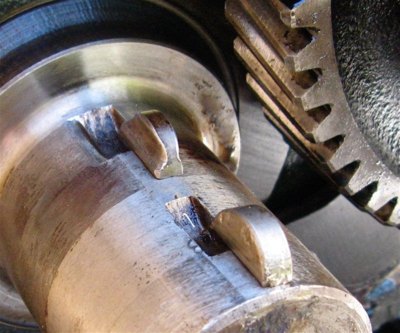Also, on rotating the engine by hand, each time I past TDC, I got a slap like sound.
In tearing the engine down (I'm swapping it with an SD-22 in the thread below), I removed the pulleys and nut. I found the cup like washer in and odd condition. In two pieces, it appeared to be held together with some rubber like adhesive(?) This fits over the outer Woodruff key. (The cup is not in the photo)
But when I pulled the timing gear off the shaft, I could see what was causing the 5 degrees of play. The Woodruff key (in the photo now removed and placed on the shaft to show the wear) had worn the keyway to near double size. The key itself had worn into a pivoting like shape. I can't believe it's held together.
Has anyone come across this problem? What do you think may have caused it? One mechanic speculated the keyway may have been oversized at build. (74',...?) Another person commented it could be poor design for the forces.(I've never seen it mentioned here)
I've owned this engine for 10 years and run it seasonally in Maine in our boat. It's always smoked a bit (I can see why now) but has run smoothly. Lately, it's been rougher idling but smooth under power.
Sadly, the rest of the engine, including cylinders (there was no ridge or noticeable scoring), looked pretty good.
